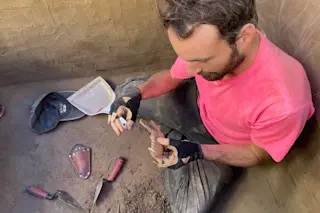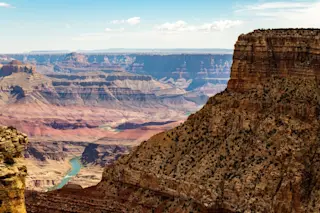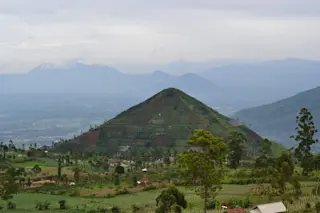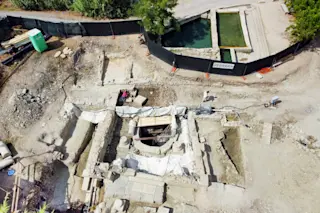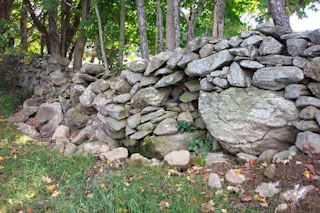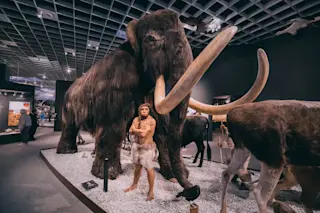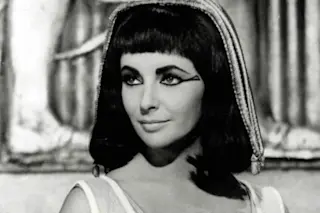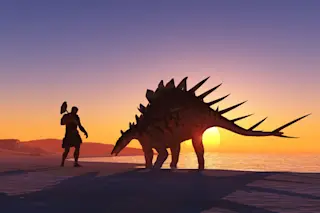Caral’s first rulers must have been supremely obstinate. To build a city on a continent that may never have seen one before, to create a community out of mud and cobbles and hand-hewn boulders in the grimmest of deserts, required an almost unimaginable toughness and determination. The abandoned settlement, 120 miles north of Lima, Peru, is a vast sprawl of platform mounds, sunken circular plazas, and hivelike living quarters, encircled by gray crags and windblown sand. Few urban settings are grander, or less welcoming.
Today Caral’s sovereign is archaeologist Ruth Shady Solís of San Marcos National University in Lima. A dark-haired woman of regal bearing, she uses a cane for support as she navigates a patch of rubble. But there is nothing frail about her. “These stones have power,” says Shady, 59, peering up at the 92-foot Pirámide Mayor. “They impose authority.” For nearly a decade, she has imposed her own authority to bring Caral back from the dead. She has dug its buildings out of the dust and pried cash from the grip of reluctant benefactors. She has endured poverty, political intrigue, and even gunfire (her bum knee is a souvenir of an apparent attempted carjacking near the dig site) in the pursuit of her mission.
Lately, however, Shady has been embroiled in the fiercest battle of her career—one that may someday lead to the rewriting of human history. Her opponents are her former collaborators, Chicago-based husband-and-wife archaeologists Jonathan Haas and Winifred Creamer. Her most formidable ally is archaeologist Michael Moseley, at the University of Florida, whose thinking has long dominated discussions of how ancient South Americans made the leap from subsistence fishing to urban sophistication.
On one side:
Peruvian archaeologist Ruth Shady Solís, advancing the theories of Michael Moseley of the University of Florida, argues that Caral grew out of a fishing society many miles away. Further, she believes her opponents (and onetime collaborators) stole her ideas—as well as her thunder.
On the other:
American archaeologists Winifred Creamer and Jonathan Haas, who are married, believe the ancient city of Caral was part of an agricultural society that expanded to the coast. As for Shady’s plagiarism charges, they say weak journalism led to misunderstandings in print.
Hostilities commenced four years ago, shortly after Shady, Haas, and Creamer collaborated on a paper in the journal Science reporting that radiocarbon dating showed Caral to be the earliest known urban center in the Americas. Spread across 160 acres of the Supe Valley, the deserted city was 4,600 years old—contemporaneous with Egypt’s earliest pyramids and eight centuries older than any comparable community in the New World. Caral’s massive structures, the three researchers wrote, dated back as far as 2627 B.C. Peruvians had not yet discovered metal; it would be another 600 years before they learned to make ceramic pots. Yet the settlement, which endured for nearly a millennium, had attained an astonishing degree of social complexity. Along with the monumental architecture there was evidence of a class system, labor specialization, and organized agriculture. Seventeen lesser sites in the valley appeared to reflect Caral’s influence. So did other Peruvian polities, as far-flung as the Andean highlands and the Amazon basin, right up to the time of the Incas. Pre-Columbian civilization seemed to have started here.
The Science story received wide play. In her native country, where Shady was already something of a celebrity, the publicity only added to her lore. But in the United States—and thus in the international press—Haas and Creamer received most of the attention. News items portrayed the couple as if they had discovered the site, when in fact they simply arranged carbon datings after a trip to the area in 2000. Shady, who was the first to realize Caral’s importance, and who had labored for years to unlock its secrets, was often treated as a supporting player. Because of this, her relations with the Chicago archaeologists soured, and she refused to speak to them.
Last December, Haas and Creamer again made headlines with a paper in Nature that presented carbon datings for 13 sites with platform mounds and residential complexes in river valleys near Caral. Some appeared to be even older than Caral, with dates as early as 3200 B.C. “It is now clear,” the couple wrote, that Caral and other Supe Valley sites “were parts of a much more extensive cultural system that reached across at least three valleys and an area of 1,800 square kilometers.” They called the region the Norte Chico, a colloquial term for the north-central coast of Peru. And they mentioned Shady only in their footnotes.
Shady responded by accusing the couple of plagiarism. They had no right to present their analysis as original, she claimed, since she had long portrayed Caral as part of a larger system in her scholarly writings. “Haas and Creamer are violating not only my intellectual rights as an archeologist, but also the rights of a Peruvian research project whose authorship they intend to expropriate,” she wrote in a widely published statement. She lodged complaints with the Society for American Archaeology and with Haas and Creamer’s employers, the Field Museum and Northern Illinois University, respectively. Although the society declined to get involved (“We don’t have mechanisms for settling those kinds of disputes,” says a spokesman), the other institutions launched investigations. In Peru the National Institute of Culture, which issues excavation permits, asked the professional association for the country’s archaeologists to hold hearings on the dispute. The minister of foreign relations instructed the Peruvian embassy in Washington to raise the issue officially. The mayors of towns near Caral issued a proclamation denouncing Haas and Creamer’s “piracy.”
Some North American archaeologists praised the Nature article. Anthropologist Craig Morris, of the American Museum of Natural History in Manhattan, hailed Haas and Creamer’s work in The New York Times as “a very important beginning.” But others were highly critical of their compatriots. Betty Meggers, director of Latin American archaeology at the Smithsonian Institution and a friend of Shady’s, sent a letter to the National Geographic Society (which partially funded the couple’s work) titled “Unethical Behavior of Grantees Jonathan Haas and Winifred Creamer.” Michael Moseley told the Associated Press that Haas and Creamer were creating a “detrimental” situation for “many who have worked down here for many, many years and tried to develop good relations.” Haas and Creamer fired back, saying their work was being “slandered by people who don’t want to take time to look into it. Not one of those allegations is true.”
A century ago, in archaeology’s barnstorming days, personal vendettas were commonplace. But the Society for American Archaeology board president, Ken Ames, is nonplussed by the dustup. “This kind of accusation is quite rare,” he says. “Archaeologists fight all the time, but we fight over ideas.” Yet a visit to the disputed valleys reveals that this feud actually is about ideas, not just hurt feelings. It’s about two of archaeology’s fundamental questions: How does a civilization get started? And did it begin differently in the Americas than everywhere else?
To understand the terms of the debate, it helps to tour the garbage dump at Supe Puerto, a grimy harbor town about 20 miles northwest of Caral. The dump covers an expanse of sand dunes, one of which has a crater at the top. In this depression may be found a number of artifacts whose archaeological significance seems doubtful: newspaper pages from 1985, the skeleton of a small dog, a warped 45-rpm record of Sixto Morales singing “El Alma de la Fiesta.” But beneath the trash-strewn sand lies the main pyramid of a settlement called Aspero.
Archaeologists first visited Aspero in 1905, but they mistook its ruins for natural hills. It wasn’t until the early 1970s that Moseley, then at Harvard University, and his former professor Gordon Willey confirmed that the 32-acre site was a preceramic fishing settlement with six platform mounds. In those days, few scientists believed that monumental architecture existed in preceramic times (before 1800 B.C.); sites with platform mounds but no pottery were regarded as puzzling anomalies. And if Peruvians did build pyramids before they fired clay, it seemed unlikely that early coastal dwellers would have reached such a degree of sophistication. It takes a fairly complex society to undertake big public construction projects, and the consensus was that complexity sprang from mastering agriculture. Hunter-gatherers had neither the means nor the need to create social hierarchies. That process (which entailed the division of labor and the emergence of a managerial caste) got under way only after humans settled down to farm. Once they learned to grow enough food to nourish those not directly involved in its production, it was not far to civilization—broadly defined as a society endowed with government, social classes, urban centers, extensive trade, and widespread cultural influence. Fishermen, experts agreed, were really foragers, and their way of life offered no incentive to organize.
To Moseley, however, Aspero was evidence that fishing could be a civilizing pursuit. Peru’s coastal desert, which stretches well into the Andean foothills, gets less than an inch of rain a year; there is little natural vegetation. Without irrigation, agriculture is possible only in narrow patches of river valleys. Yet humans have occupied Peru’s coastline for 12,000 years. What drew the first nomadic bands seems to have been the bounty of anchovies, sardines, and other small fish brought close to shore by the cold Humboldt Current and the tons of bivalves at the ocean’s edge. Even today, these waters are among the richest in the world.
Food surpluses, Moseley reasoned, were possible in settlements like Aspero, at the mouth of the Supe River, once the inhabitants learned to cultivate cotton and to weave it into fishing nets. (That era, known as the Late Archaic or Cotton Preceramic Period, began about 3000 B.C.) Labor specialization would have followed, as some people spent their days fishing, others tending cotton plants, and still others twisting the fibers into nets. Small quantities of fruits and vegetables might have been grown, but the main purpose of farming would have been to bolster the supply of seafood. After a corps of priest-technicians arose to coordinate all these activities, it could have marshaled sufficient labor to raise pyramids to the gods.
In 1975 Moseley published TheMaritime Foundations of Andean Civilization, in which he declared, “The archeological axiom that only agriculture could support the rise of complex societies is not a universal truth.” In Peru, fishermen had reached the very threshold of civilization. Although it appeared that full-blown city-states emerged after 1800 B.C., with the advent of grains and pots to store them in, the crucible of complexity lay on the preceramic coast.
Moseley’s theory, dubbed the maritime hypothesis, was widely regarded as heretical, but it gained credibility after radiocarbon dating proved that Aspero had flourished as early as 3055 B.C. By the mid-1980s, the maritime hypothesis had become the dominant paradigm. Then, in 1996, Ruth Shady—a veteran archaeologist who had spent two years exploring other sites in the area—started digging in Caral, 12 miles up the Supe Valley.
Like Aspero, Caral had been on archaeologists’ radar for decades, yet no one had known what to make of it. Shady agreed with those who thought it was a preceramic site, and her own excavations convinced her that the two settlements were part of the same culture. Soon it became evident that Caral was a true city-state, roughly contemporary with Aspero but far larger and more advanced. “That,” she says, “is when I realized that I had stumbled across a problem that would change the way we perceive history in my country.”
Shady remained loyal to the basic premise of the maritime hypothesis. But as she and Moseley discussed her findings, they agreed on some modifications. The first was that Peruvian civilization was born in Caral and that it emerged far earlier than previously suspected. Furthermore, fishing’s effects could not be viewed in isolation from those of farming and commerce. Caral, Shady theorized, may have started as a colony of Aspero, an agricultural outpost charged with providing raw material for nets. But the new community’s location was one of the easiest places in all Peru to construct an extensive irrigation system. Caral’s residents grew industrial quantities of cotton, along with tropical fruits, beans, chilies, gourds, and wood; they traded these for fish, mollusks, and salt from Aspero and other coastal towns. Caral was also well situated for more extensive trade, with the neighboring valleys and beyond. The city exported its own products and those of Aspero to distant communities in exchange for exotic imports: spondylus shells from the coast of Ecuador, rich dyes from the Andean highlands, hallucinogenic snuff from the Amazon.
These enterprises, Shady speculated, were so profitable that Caral quickly outgrew its progenitor in both size and sophistication. At its height, perhaps 3,000 people lived in the city. They remodeled their pyramids at regular intervals, burying the old structures in reed bags full of rocks, tossing in sacrificial objects (clay figurines, human sacrifices), and covering everything with a new skin of cut stone and colored plaster. Priests burned offerings at the top of the multilevel platforms, as each layer of society gazed up from its proper elevation. Caral’s workshops produced jewelry made of shells and semiprecious stones. Its musicians played flutes made of condor and pelican bones in an amphitheater lighted by sacred fires. Its nobles sat on stools made of blue-whale vertebrae and ate all the dried anchovies and mussels they desired.
In early 1999 Jonathan Haas invited Shady to lecture at the Field Museum. Haas had done some graduate work in Peru years earlier, but he and his wife had gone on to work in New Mexico. Both had risen to the top of their profession—he specialized in the origins of politics among Southwestern Indians, she in prehistoric Native American architecture—and they were looking for new fields to explore. Peru seemed the ideal territory and a collaboration with Shady the perfect opportunity.
When Haas and Creamer visited Caral soon afterward, they proposed the carbon dating and coauthoring the Science paper with Shady. At the time, funds for Caral were so scarce that Shady had to enlist soldiers from a nearby base to do her excavating. Although the municipality had recently built her a dig house (until then, she set up a tent), her workers often got sick from drinking contaminated water. Haas’s pitch, she says, was that the partnership would be to her advantage; as a stateside coauthor, he could secure grants for her project—hard to come by in impoverished Peru—from U.S. sources.
“I put them up in my house,” says Shady. “I drove them around in my car. I didn’t realize that these people were delinquents.”
Winifred Creamer certainly doesn’t look like a delinquent. Tall and lanky, with cropped gray-blond hair, she strides across the site known as Bandurria like a happy field marshal. “Let’s map that mound!” she shouts to a young assistant, Manuel Perales, who is outfitted for the task with a Global Positioning System receiver. The apparatus—a handheld computer and a plastic antenna that pokes up like an ostrich head from a yellow backpack—scans the landscape as he walks, recording every rise and gully in coordination with a GPS satellite overhead.
Creamer, 54, is leading a team of Peruvian archaeology students in surveying the three valleys that connect by ancient foot trails with the Supe: the Pativilca and Fortaleza to the north, and the Huaura to the south. She’s the kind of boss who inspires hard work—solicitous of her underlings’ opinions, attentive to the vagaries of their personal and professional lives, eager to swap scientific information or a good joke. And she toils as diligently as her crew, starting her workdays at dawn and ending them, huddled over a PC in her dig house, after 9 p.m. The survey’s aim is to catalog every known archaeological site in the area and to discover new ones in the process. “In another 5 or 10 or 20 years,” Creamer says, “when a certain portion of these sites disappear, at least there’ll be some data you can work with.”
Bandurria, a coastal site at the mouth of the Huaura Valley, is on the endangered list. Haas, Creamer, and Shady all agree that this settlement—now a cluster of sandpiles overlooking a salt marsh, half a mile from the Pacific—may have equaled Aspero in preceramic times. But a group of squatters has built adobe shacks atop an ancient trash midden, or mound, and a local landowner may be planning to build a housing development over the buried pyramids. Although Peruvian laws protect archaeological sites, a lack of funds for enforcement renders the statutes largely theoretical. “Lots of sites are used as public toilets,” Creamer says with a grimace.
Creamer hopes to dig in Bandurria, which remains virtually unexcavated, before it succumbs to real estate pressures. But she and her husband reject the idea that Peruvian civilization got its start here by the sea. They made that clear soon after the Science article on Caral appeared in April 2001. An editorial in that issue suggested that Caral’s newly proved antiquity “casts doubt on a favorite idea of many Andeanists: the maritime hypothesis of the origins of Peru’s civilizations.” In a subsequent issue of the journal, Moseley defended the hypothesis, noting that Aspero’s dates were still earlier than Caral’s. Haas and Creamer published a rebuttal to Moseley’s letter, calling Aspero “a tertiary residential center with minor public architecture.”
By then, Shady was already stewing over news reports in which the couple were credited with unearthing Caral and quoted in ways that seemed to confirm the error. The Smithsonian’s Betty Meggers thinks the couple were trying to one-up Shady. “They’ve been far more aggressive than other North Americans I know working in Peru,” she says. Haas and Creamer, however, say they were also distressed by the press coverage and that they attempted to correct it. In May 2001 Haas sent a letter of “clarification” to colleagues and news organizations. “We note with deepest regret that much of the media coverage did not give Dr. Shady and her students appropriate attention,” he wrote, “and we publicly apologize for any role we may have played in the misapprehension.” But a few weeks later, when Haas and Creamer met with Shady to discuss future projects, she refused any further collaboration. The two sides have not spoken since. “We did what we could to try and make amends,” says Creamer, who blames the rift largely on sloppy reporters. “She wouldn’t let us fix it.”
Haas and Creamer stopped trying. In 2002 they set up the Proyecto Arqueológico Norte Chico and gathered a research team composed of graduate students from Shady’s university—the only local institution, they say, that could provide qualified candidates. Among the recruits was Alvaro Ruiz, who became project director. (Ruiz is the son of a prominent Peruvian archaeologist; Shady had been the maid of honor at his parents’ wedding.) The couple bought a dig house of their own and started their survey. And in their December 2004 Nature article, cowritten with Ruiz, the couple disavowed the maritime hypothesis more forcefully than ever. On the basis of 95 new carbon datings in the Pativilca and Fortaleza valleys, they wrote, “it is not feasible to view the maritime development of Aspero as having preceded the large-scale inland occupations.”
In Haas and Creamer’s view, a complex society arose in Peru the same way it did in the world’s five other “pristine” civilizations (Mesopotamia circa 3500 B.C., Egypt circa 3000 B.C., India circa 2600 B.C., China circa 1900 B.C., and Mexico circa 1200 B.C.): as a result of irrigation agriculture. Their theory is a version of the “hydraulic hypothesis” proposed by the German American historian Karl Wittfogel in his 1957 book Oriental Despotism. Wittfogel argued that irrigation was the catalyst that transformed tribal societies into city-states; it required forced labor, central planning, and a managerial elite and provided the excess food necessary to support managers.
Haas and Creamer add a few amendments: They believe that labor in the Norte Chico was based on religious obligation (though outlying communities may have been raided for workers); they also believe that trade with the coast helped fuel the inland cities’ prosperity. “Wittfogel says, ‘When you control irrigation, you control the society,’ ” says Haas, a wiry, goateed 57-year-old who is the Field Museum’s curator of North American anthropology. “I think when you control irrigation you control the economic resources of the society, and that’s what they’re using to get these great big mounds built.” Fishing was merely a contributing factor. Civilization in Peru flowed from the valleys to the sea.
Haas concedes that further excavation at Aspero, which Shady plans to do this fall, may yield dates even earlier than the oldest known inland sites. (Indeed, deeper digging at Caral recently pushed back its age to 2900 B.C.) But given the destruction of several of those sites over the past few years, he says, “We’re never going to know what the earliest dates are.” The best evidence against the maritime hypothesis, he says, can be seen on a map of Peru’s archaeological sites. “If the exploitation of marine resources is the reason for cultural complexity, why don’t you get a string of these big, complex societies up and down the coast? You don’t.” Aspero and Bandurria, Haas maintains, grew as complex as they did only because they could trade with inland settlements that had been revolutionized by irrigation agriculture. And neither of those coastal sites can compare with someplace like Caral.
Not that Caral is all it’s cracked up to be. “I don’t think there’s any evidence that it’s the capital of the region,” Haas says, observing that several yet-to-be-excavated sites are larger or contain more monumental architecture. “There isn’t any evidence that the system was centralized or that Pativilca and Fortaleza were under the hegemonic rule of Caral. I think what these settlements were doing was competing for participants, with the biggest monuments and the biggest celebrations. I mean, it’s a very different kind of idea.”
Michael Moseley has watched the battle over Caral with some bemusement. He knows the players on both sides: Creamer was his undergraduate research assistant at Harvard in the 1970s, and he first encountered Haas when Haas was a graduate student at Columbia University, working in Peru under one of Moseley’s former students. Moseley has met Shady only a few times, but the two have corresponded for years. “I think all three of these people are very capable archaeologists,” he says. “It’s too bad that this blew up, because it’s detracting from the archaeology, which is spectacular and revolutionary.” He attributes the clash to a quality that Shady, Haas, and Creamer share with many other successful archaeologists: “They have huge egos.”
Moseley has his own ideas about Caral. Although he believes it was the preeminent city of the preceramic era, he suggests that its residents were mostly part-timers. “You have large populations,” he says, “but they’re not there the whole year. They go back to the coast during the off-ag season, until it’s time for planting or harvesting.” Nonetheless, he stands firmly with Shady. He has publicly decried Haas and Creamer’s “academic imperialism,” and he helped Shady secure a Heinz Foundation grant to return to Aspero.
Moseley gives the American couple credit for advancing the scientific study of Late Archaic sites. But he objects to what he sees as Haas and Creamer’s campaign to prove that Peru’s past is not unique. “Shady and I and many Andeanists would look at Peru—not just in the preceramic but in later adaptations—as being different from most other trajectories of civilization,” he says. “Haas and Creamer, on the other hand, try to fit everything into a stretch-sock model. You have one trajectory, and it’s agriculture, and that does it. So there is a philosophical difference here.”
Philosophy aside, he is waiting for more data. The rival teams are collecting pollen samples, coprolites (ancient feces), and household trash, trying to determine more precisely what the people of the valleys ate. If their calories came mostly from plant products, for example, that might sink the maritime hypothesis. So far, the results are ambiguous. Haas and Creamer have found traces of maize in 17 out of 27 pollen samples but only a few tiny fragments of actual corn. Anchovy bones and mollusk shells are abundant at all the sites, but less so at the inland locations than at Aspero; indeed, a sacrificial victim found at Caral showed signs of protein deficiency and chronic anemia. The most reliable evidence of a seafood-heavy diet is a high strontium level in the human skeleton, but no one has yet found a full-scale Late Archaic cemetery. So far, says Moseley, “I don’t see any reason to back off.”
Neither does Ruth Shady. She is used to persisting, and prevailing. In 2003, for example, after a struggle over funding with the rector at San Marcos, she petitioned the government to make the Caral project independent of the university; today Shady oversees a federally mandated budget of more than $600,000 a year. Caral is immaculately restored, its stone facades gleaming beneath the tropical sun. Shady’s team is excavating three nearby sites and studying what appears to be a sort of underground astronomical observatory. Tourists are beginning to brave the bone-shaking road to the site; last year, attendance more than doubled, surpassing 15,000. “It’s incredible that she’s been able to push ahead in spite of all the problems,” says the Smithsonian’s Meggers.
Someday Haas and Creamer would like to excavate a city, too, perhaps Caballete, a 150-acre site in the Fortaleza Valley to the north that features mounds nearly the size of Caral’s and a plaza ringed by six-foot-tall standing stones. For now, though, the couple are sticking to less glamorous but equally important tasks. “They’re taking the foundations Shady laid in the Supe and putting that understanding to work in other valleys,” says Mark Aldenderfer, an archaeology professor at the University of California at Santa Barbara who works in southern Peru. “You really need to look at a much bigger picture, and that’s their innovation.”
Haas and Creamer are also grappling with the consequences of their feud with Shady. Although they were exonerated of Shady’s charges of plagiarism by their respective institutions, the Field Museum’s science advisory council scolded Haas for approving and editing press releases and Web pages that “gave too little credit” to Shady and inflated the couple’s role as discoverers. “It behooves any researcher to be certain that inaccuracy and exaggerations, especially those that may be taken to denigrate the contributions of others, are absent from material under his or her control,” the seven council members wrote in their report. “In their actions at the Field Museum (and we do not comment on those elsewhere), Drs. Haas and Creamer did not consistently do so.” The pair have hired lawyers to negotiate with Peru’s archaeological authorities, and they worry that the controversy will affect their funding and staffing.
Like their adversary, however, they are tough and determined. They plan to study the Norte Chico for at least the next 12 years. “The important thing is to get on with our research,” says Haas. “The research is going to answer most of these issues. I’m not sure that’s what the other side wants.”



